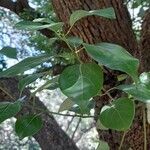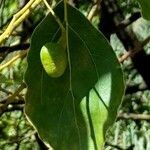Evergreen trees, 5-15(-20) m tall, up to 30 cm d.b.h. Bark gray-brown, longitudinally deeply fissured, peeling off in lamellae, red-brown inside, camphor-scented. Branchlets green-brown, robust, terete; young branchlets angled. Buds ovoid, large; bud scales suborbicular, densely sericeous. Leaves alternate; petiole 1.5-3(-3.5) cm, robust, concave-convex, subglabrous; leaf blade usually glaucous and greenish abaxially, dark green and shiny adaxially, very variable in shape, elliptic to ovate-elliptic or lanceolate, 6-15 × 4-6.5 cm, those on fertile branchlets smaller, leathery, puberulent abaxially only when young, glabrous on both surfaces or glabrous adaxially and ± puberulent abaxially when mature, pinninerved or occasionally subtriplinerved, lateral veins 4 or 5 pairs, lateral veins and midrib conspicuous on both surfaces, oblique, gradually evanescent within leaf margin, axils of lateral veins dome-shaped and hairy or glabrate abaxially, conspicuously bullate adaxially, transverse veins and veinlets reticulate, fine and inconspicuous, base cuneate or broadly cuneate to subrounded, sometimes unequal on sides, apex generally acute to shortly acuminate. Panicle axillary, shorter than leaf blade, 4-10 cm; peduncle 2-4 cm, peduncle and rachis glabrous. Pedicels short, 1-2 mm, glabrous. Flowers small, up to 3 mm, yellowish. Perianth sparsely white puberulent outside, pubescent inside; perianth tube obconical, ca. 1 mm; perianth lobes 6, broadly ovate, subequal, ca. 2 × 1.7 mm, acute. Fertile stamens 9, ca. 1.4 mm (of 1st and 2nd whorls) or ca. 1.6 mm (of 3rd whorl); filaments complanate, pubescent, those of 3rd whorl each with 2 shortly stalked cordate glands near base, others glandless; anthers ovate, almost as long as filaments (of 1st and 2nd whorls) or oblong and ca. 1 mm (of 3rd whorl), all 4-celled; cells introrse (of 1st and 2nd whorl) or extrorse (of 3rd whorl). Staminodes 3, narrowly triangular, including stalk less than 1 mm; stalk pubescent. Ovary ovoid, ca. 1.2 mm, glabrous; style slender, ca. 1.2 mm; stigma discoid, inconspicuously 3-lobed. Fruit black, globose, up to 1 cm in diam.; perianth cup in fruit red, narrowly obconical, ca. 1 cm, longitudinally striate, base ca. 1 mm wide, apex up to 6 mm wide and undulate on margin. Fl. Mar-May, fr. Jul-Sep.
More
An evergreen tree. It grows 5-15 m tall. The bark is brown. It has cracks along it. The branches are robust and angular. The leaves are alternate and narrowly oval or sword shaped. They are 14-16 cm long by 4-7 cm wide. The flowers are small and have both sexes. They are light yellow and hairy and in groups. These are 4-10 cm long. The fruit is round and 10 cm across. It is black.
Can be grown by cuttings or seedlings. Seeds needs soaking.



